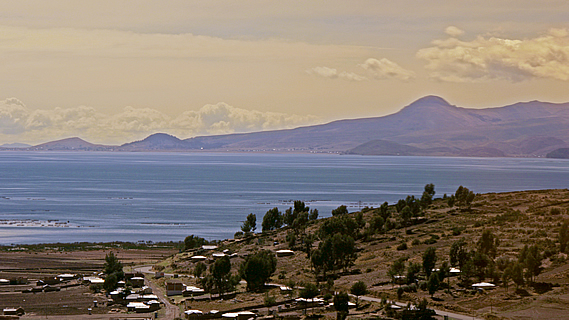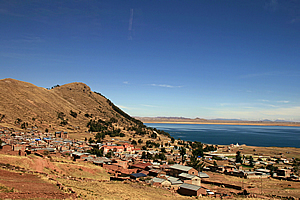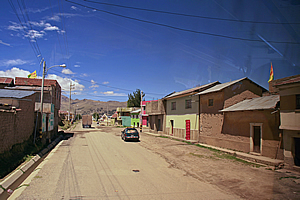--- Archive files ---
Home > Travels > Titicaca > 8 |
A Relaxed Border Crossing

LAKE Titicaca is bordered by two countries – Peru and Bolivia. No exploration of the lake could be complete without visiting both countries.
Early in the morning following the usual mundane South American hotel breakfast of Fanny jam on buns and aniseed tea, we caught a minibus to the main bus station. We arrived at the Puno bus station, where Carlos checked us in, and allocated seats for us. Unfortunately the bus was only a single level, and our seats were all about half way back in the bus so there weren’t going to be the uninterrupted views out the front as there had been the other day coming from Cuzco. We put our bags in the hold before climbing on board to find our seats.
Village beside the lake |
I found a seat within our seating range. These seats were very claustrophobic all being squeezed up too close to each other, not to mention the windows were a ghastly sepia colour.
The bus left and sped off along the road roughly following the edge of the lake. There were several fish farms in the lake, and on its shores was farmland on the arid brown grass. Clumps of straw were occasionally bunched up. In the distance across the lake I could see the huge snow capped mountains of the main dividing range of the Andes. High cirrus cloud spectacularly hovered above. They would have been a good ten kilometres above sea level but as we were almost four kilometres up they appeared very close and spectacular.
We reached the occasional village, desolate with no people around. Tall power cables stood in amongst the single storey mud brick houses that lined the dusty streets. Through the sepia windows these villages epitomised the whole ghost town notion. The buildings had reinforcing wire coming out of the top giving the impression they had been abandoned mid construction. However having seen a lot of these houses throughout Peru (though not in as bad a condition as this) then I knew they were completed houses where people actually lived.
The bus continued along the well maintained highway for about half an hour after leaving Puno until we stopped at a bank in a town almost at the border of Bolivia. It wasn’t a bank as most people would know it. The building was just a small shop painted a depressing pale blue grey on its otherwise bare walls with a few shelves of things you can buy. Near the back of the tiny shop was a desk with a few bankers exchanging money with the people standing at the front of the rather long queue going almost to the door. I couldn’t see any security here. Fortunately the queue moved quickly and I exchanged most of my Peruvian Neuvo Sols to Bolivianos. I kept a few Peruvian notes and coins for my collection.
Last town before the border |
Once our money was exchanged, the bus continued for another two kilometres before it suddenly stopped at the small border town of Yunguyo. We got out and took our luggage to a small building on the side of the road where a rather long queue was waiting. This was one immigration point like no other I had ever been through. This was a very small building the size of a corner store. It had two doors in the front. Everyone was queued up at the door to the right, and the door to the left was where people with their passports stamped were leaving.
I had only ever crossed immigration on land in South East Asia, and even there the security was a lot tighter than it seemed to be here. Looking up the road the border was about twenty metres away at the crest of a hill. Large bollards were placed across the width of the road. Beyond the bollards the village continued. I wondered whether the locals here just walked across the border all the time to get from one side to the other.
The queue moved fairly quickly allowing us to eventually enter the building. Once inside a policeman directed me to an old plain wooden desk where a woman stamped my passport. Now I was officially in no man’s land.
From there we walked out of the exit door and walked up the final part of the short hill to the bollards. From there I had quite a good view of the lake with the sweeping hills creating nice bays. It was good to see the view without the sepia window. Once across the bollards I was unofficially in Bolivia. We walked a short distance down the hill down the other side where we entered a very similar building to get our arrival stamps. The white facing above the door had a government notice on top saying “Ministerio De Gobierno Migracion Kasani Bolivia”.
A rather cherry policeman stood just inside the door examining each person’s passport to see if they had been stamped before leaving Peru. He made a little joke about everyone’s passports. When he got to mine, he looked at it and said “You’re a kangaroo” and did some lame kangaroo hops. He was very funny – particularly as one seldom gets so much as a grunt from immigration officers in any other border crossing I had ever passed through.
I proceeded to the desk and a man stamped my passport with hardly a glance – okay so they do have faceless officers even here in Bolivia. With my passport stamped I was officially in Bolivia.
As we were heading back onto the bus Carlos suddenly mentioned he had left his passport at home in Cuzco. Amazingly immigration let him through into Bolivia anyway. Obviously he does the border crossing on a regular basis and would most likely know the people at the immigration counter. I had observed the immigration there was very relaxed compared to any other border crossings I had ever done, but I had no idea that it was this relaxed.
Carlos was concerned that he was not going to be able to get back into Peru following the end of the tours in about two weeks’ time. I later heard that he did manage to get back into Peru through this border crossing without his passport so that was very fortunate.
<< Previous | Next >> |
|
||
About this Page
|
||
|
|
|
Where is Walkabout Jeff? |
|
|
|
|
What is happening in Walkabout Jeff's hometown?
|
|
|
|
|
Who is Walkabout Jeff?Any normal person's idea of going out involves going to the local pub for a drink with a few mates. Walkabout Jeff isn't normal.
|
|
|
|
|




